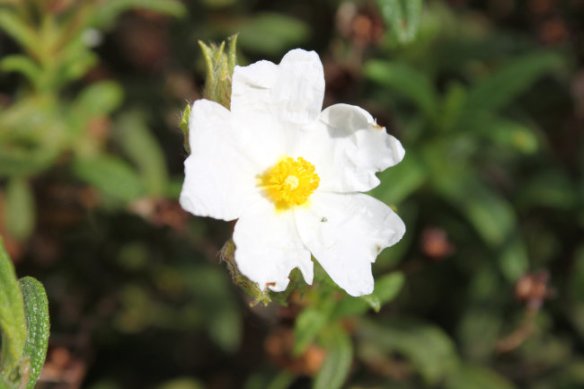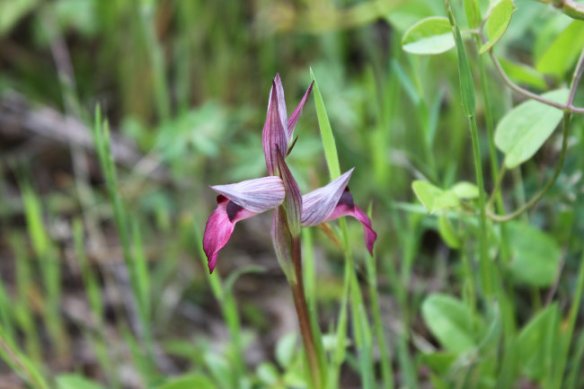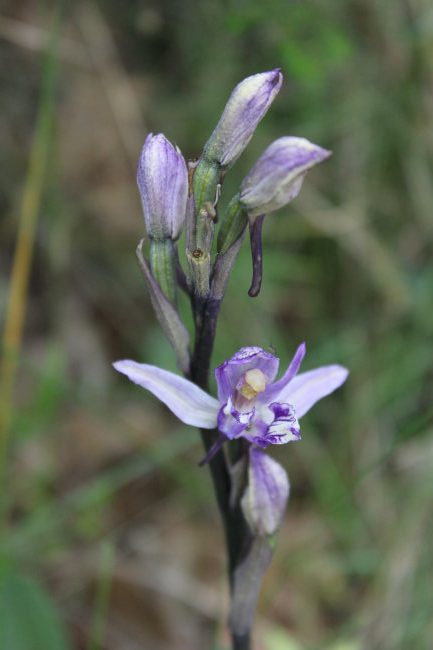You may have come across cistus plants under their common name of rock rose. They grow very abundantly in the area around Saint-Chinian, and right now they are flowering their hearts out. I went on a little photo safari last Saturday, to shoot a few pictures for you.
In the map below, you can see the itinerary I followed for my walk, and this link will take you to the geoportail website, where you can see the map, albeit without the itinerary markings.
I started my walk by the cooperative winery in Saint-Chinian. Most of the walk was on fairly well kept tracks which are used by vineyard workers and hunters. If you want to do the walk yourself, you should wear reasonably sturdy shoes – high heels are definitely out of the question!! The whole walk can be completed in an hour. Of course it took me longer since I stopped frequently to take pictures! 🙂
Before starting the walk proper, I visited the cistus display bed beside the cooperative winery in Saint-Chinian. It was planted some years ago, and all of the plants have now reached maturity. A plaque by the bed identifies the various species on show:
Cistus plants thrive in a Mediterranean climate and grow well on poor soils. According to the wikipedia article, the seeds can lay dormant for up to 100 years before germinating.
Around Saint-Chinian, the most commonly encountered species of cistus are C. monspeliensis:
… C. albidus:
… C. ladanifer:
… and C. salviifolius:
The display bed at the cooperative winery also contains a species which is more rarely seen around here: C. populifolius:
The plant in the following picture was also growing in the display bed, but I could not find it on the panel. Cistus species hybridise readily, so, if my identification is correct, this should be C. x purpureus, a cross between C. ladanifer and C. creticus. It’s a plant with very pretty flowers, and you can see the heritage from c. ladanifer with the purple blotches at the base of the petals!
As I was starting my walk, I walked past this stand of trees. A nightingale, well hidden from view, was singing directly at me. I thought I would share the video with you!
My walk took me up and down some gentle slopes – being a little higher than the surrounding countryside always makes for nice views!
The first flower picture I took after I started my walk was of an orchid – orchis provincialis:
It wasn’t long before I came to a clump of C. salviifolius by the side of the path.
Wild garlic was also in flower along the path. The flowers have a pleasant onion/garlic flavour and can be added to salads.
I couldn’t pass by this doughnut-shaped tree lichen without taking a picture!
Farther along I found a clump of C. albidus in full flower, it’s pink flowers standing out nicely from the the grey, woolly leaves.
Nature’s flower arrangements are always worth studying – here we have lavender and heather flowers, with a background of blackberry leaves! 🙂
The leaves of some cistus species secrete a sticky substance which has a lovely resinous fragrance. C. ladanifer is one of these species. Incidentally, the picture below shows the point where the walk starts to loop back.
I came across some more Orchis provincialis – a whole stand of them, in fact. The leaf rosette showed the typical brown splotches.
 In this close-up you can see some of the delicate markings on the flowers:
In this close-up you can see some of the delicate markings on the flowers:
I rounded a bend in the path and came to this wonderful sight: a whole hillside covered in flowering cistus bushes!! The photograph doesn’t really do it justice – it was spectacular to behold!
 Here’s a picture of C. monspeliensis – you can see the leaves glistening with the sticky resin.
Here’s a picture of C. monspeliensis – you can see the leaves glistening with the sticky resin.
I found some interesting flowers towards the end of my walk: Serapias lingua is an orchid whose flower petals are like tongues sticking out at you (or me).
I’ve not been able to identify the following flower, but I think it’s a species of vetch.
 Then I found a rather mysterious looking plant – it’s fairly tiny, with a pitcher like flower and one petal folded over that like a lid. From the top you just see a kind of purple black leaf, about the size of a thumbnail, but when you tilt the flower somewhat, you can see that it’s part of the flower which is pitcher shaped. I immediately wondered if it was part of the arum family or a carnivorous plant. Looking through some of the plant books I have at home, it turns out to be Aristolochia pistolochia.
Then I found a rather mysterious looking plant – it’s fairly tiny, with a pitcher like flower and one petal folded over that like a lid. From the top you just see a kind of purple black leaf, about the size of a thumbnail, but when you tilt the flower somewhat, you can see that it’s part of the flower which is pitcher shaped. I immediately wondered if it was part of the arum family or a carnivorous plant. Looking through some of the plant books I have at home, it turns out to be Aristolochia pistolochia.
I found a violet limodore orchid just around the corner from the mystery plant above:
The last picture I took on my walk is of a white flowered tamarix shrub. With the flowers not yet quite open, the buds look like white peppercorns, tightly clustered on the branches. I’m sure it’ll look gorgeous in a week or so.
 I hope you enjoyed the wonderful flowers that can be found around Saint-Chinian. Thanks for coming along with me on this wonderful walk!
I hope you enjoyed the wonderful flowers that can be found around Saint-Chinian. Thanks for coming along with me on this wonderful walk!

























I love a rock rose! Thank you for this informative post. I have learnt a lot.
LikeLiked by 1 person
My pleasure June!!
LikeLike
Someone wrote in with this:
The mystery plant that your contributor found on his sortie was, I would say, Aristolochia rotunda rather than Aristolochia pistolochia, which has hairier more felty leaves. The Aristolochiae are known commonly as birthworts in English. Lovely photo!
LikeLike